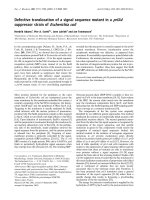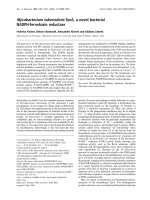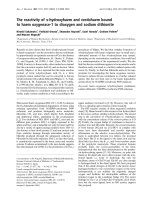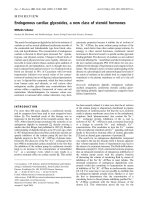Báo cáo y học: " Systemic lupus erythematosus: a BLySful, yet BAFFling, disorder" pps
Bạn đang xem bản rút gọn của tài liệu. Xem và tải ngay bản đầy đủ của tài liệu tại đây (44.23 KB, 3 trang )
136
APRIL = a proliferation-inducing ligand; BAFF = B-cell activating factor; BAFFR = BAFF receptor; BAHTs = BLyS/APRIL heterotrimers; BLyS =
B-lymphocyte stimulator; BLyS/BAFF = B-lymphocyte stimulator/B-cell activating factor belonging to the TNF family; Fc = crystallizable fragment;
mAb = monoclonal antibody; RA = rheumatoid arthritis; SLE = systemic lupus erythematosus; TNF = tumor necrosis factor.
Arthritis Research & Therapy Vol 5 No 3 Stohl
Introduction
BLyS (B-lymphocyte stimulator), also commonly known as
BAFF (B-cell activating factor), is a 285-amino-acid
member of the TNF- (tumor necrosis factor)-ligand super-
family [1–5]. (Because the two names are both so
common, I use them interchangeably throughout this com-
mentary.) It is a vital B-cell survival factor [6–8], and mice
genetically deficient in BAFF display profound global
reductions in mature B cells and in circulating
immunoglobulin levels [9,10]. Conversely, constitutive
overexpression of BAFF in BAFF-transgenic mice leads to
expanded B-cell populations and polyclonal hypergamma-
globulinemia [5,11,12]. This association between elevated
circulating levels of BLyS and polyclonal hypergamma-
globulinemia extends to humans as well, inasmuch as
increased serum and/or plasma levels of BLyS have been
documented in human systemic lupus erythematosus
(SLE), rheumatoid arthritis, Sjögren’s syndrome, and HIV
infection [13–16], all conditions associated with poly-
clonal hypergammaglobulinemia.
Therapeutic antagonism of BLyS/BAFF
Of paramount importance to human autoimmune diseases
associated with pathogenic autoantibodies (especially
SLE), constitutive overproduction of BAFF in mice not only
leads to B-cell expansion and polyclonal hypergamma-
globulinemia, but also often leads to elevated circulating
titers of multiple autoantibodies (including anti-dsDNA),
circulating immune complexes, and immunoglobulin
deposits in the kidneys [5,11,12]. Moreover, SLE-prone
NZB × NZW F1 and MRL-lpr/lpr mice harbor elevated cir-
culating BAFF levels, and treatment of these mice with a
BAFF antagonist ameliorates progression of disease and
improves survival [5,17]. Although humans are not simply
large mice, it does not take a great leap of faith to postu-
late that elevations in circulating BAFF levels contribute to
development and/or maintenance of SLE in humans and
that blockade of BAFF activity could be therapeutically
beneficial.
Borrowing from the successful clinical experience with
TNF antagonism in rheumatoid arthritis and Crohn’s
disease, anti-BLyS monoclonal antibody and/or fusion pro-
teins between any of the three known BLyS receptors
(BCMA; TACI; BAFFR) and the Fc portion of IgG could
bind and neutralize circulating BLyS. Although BLyS
receptor fusion proteins are still undergoing preclinical
evaluation, a phase-I clinical trial in SLE with a fully human
Commentary
SLE
Systemic lupus erythematosus: a BLySful, yet BAFFling, disorder
William Stohl
Division of Rheumatology, University of Southern California Keck School of Medicine, Los Angeles, CA, USA
Corresponding author: Williams Stohl (e-mail: )
Received: 13 Feb 2003 Accepted: 5 Mar 2003 Published: 27 Mar 2003
Arthritis Res Ther 2003, 5:136-138 (DOI 10.1186/ar755)
© 2003 BioMed Central Ltd (Print ISSN 1478-6354; Online ISSN 1478-6362)
Abstract
BLyS/BAFF (B-lymphocyte stimulator/B-cell activating factor) is a vital B-cell survival factor.
Overexpression of BLyS in mice may lead to systemic-lupus-erythematosus-like (SLE-like) disease, and
BLyS overexpression is common in human SLE. Treatment of SLE-prone mice with a BLyS antagonist
ameliorates disease progression and enhances survival, making BLyS an attractive therapeutic target
in human disease. However, several unresolved issues remain, including what is the contributory role of
APRIL (a tumor-necrosis-factor superfamily member related to BLyS) in the ‘autoimmunogenic’ effects
of BLyS, identification of the ‘optimal’ BLyS antagonist, and identification of those SLE patients most
likely to benefit from BLyS antagonist therapy.
Keywords: APRIL, B cells, biologic antagonists, BLyS/BAFF, SLE
137
Available online />antihuman BLyS monoclonal antibody was initiated in early
2002. All the patients had received their test drug (or
placebo control) by the end of 2002. Post-treatment
follow-up of these patients should be complete by mid-
2003, with safety and pharmacokinetic data emerging
shortly thereafter.
Biologic antagonists directed against BLyS and/or its
receptors need not be limited to monoclonal antibody or
receptor fusion proteins. Other attractive candidate bio-
logic antagonists include BLyS analogues that competi-
tively bind to BAFFR (the BLyS receptor absolutely
essential to the BLyS-driven biologic effects on B cells
[18,19]) but cannot trigger signaling. Alternatively,
BAFFR-blocking agents that render the receptor inacces-
sible to BLyS binding could also be clinically efficacious.
Indeed, there is no a priori reason that such antagonists
must necessarily be biologic. They could be low-molecular-
weight synthetic compounds as well. In any case, develop-
ment of appropriate BLyS analogues and/or BAFFR
blockers will require more detailed studies of
BLyS/BAFFR interactions and how (whether) other cell-
surface structures affect such interactions.
APRIL: the wild-card factor
APRIL (a proliferation-inducing ligand) is a member of the
TNF-ligand superfamily related to, but distinct from, BLyS.
APRIL binds to two of the three known BLyS receptors
(BCMA and TACI) [20–23] but not to BAFFR [18]. Given
its inability to bind to BAFFR, it has been believed that
APRIL has little (if any) effects on B-cell biology. Indeed,
constitutive overexpression of APRIL in APRIL-transgenic
mice does not lead to overt B-cell abnormalities or sero-
logic or clinical autoimmunity [24]. However, APRIL and
BLyS can form BLyS/APRIL heterotrimers (BAHTs), which
do have ‘BLyS-like’ biologic activity in vitro and which do
circulate in vivo [25]. Whether BAHTs exert in vivo bio-
logic activity and, even if so, what fraction of total ‘BLyS’
biologic activity is exerted by BAHTs rather than by BLyS
homotrimers remain open questions that require resolu-
tion. The answers to these questions may have profound
ramifications for antagonist therapy, since a clinically effi-
cacious BLyS antagonist may need to be directed against
not just BLyS but against APRIL as well.
Are all SLE patients candidates for
BLyS/BAFF antagonist therapy?
The answer to this question depends upon how one views
the role of BLyS/BAFF in SLE. In principle, BLyS may
assume at least two distinct functions as it pertains to SLE.
The first model has BLyS functioning as a contributor to
development of SLE. BLyS per se does not cause loss of
tolerance to self-antigens. However, once such tolerance is
broken, the ever-present nature of the autoantigen permits
it to stimulate the host immune system repetitively, resulting
in a detectable autoimmune response. In the presence of
increasing amounts of BLyS, the autoimmune response is
exaggerated. In the presence of additional permissive
genetic and/or environmental factors, this exaggerated
autoimmune response can lead to frank clinical disease.
According to this first model, reducing SLE-contributory
BLyS levels to ‘normal’ should ameliorate disease by sup-
pressing the BLyS-driven acceleration or exaggeration of
the autoimmune response. Self-tolerance would not be
‘unbroken’, but the magnitude of the autoimmune
response would be insufficient to drive clinical disease.
Thus, SLE patients with the most elevated circulating
BLyS levels should be the ones most responsive to BLyS
antagonist therapy. Those patients with normal circulating
BLyS levels might be relatively resistant to BLyS antago-
nist therapy, since ‘excess’ BLyS is not driving clinical
autoimmunity in these patients.
A second, alternative model has BLyS functioning as a
passive facilitator in development of SLE. In this model,
development of the pathologic antiself response is inher-
ently BLyS-independent. Regardless of whether BLyS
levels are normal or elevated, the magnitude of the autoim-
mune response is similar. That is, the trigger of autoimmu-
nity elicits a response so robust that it is not further
amplified by elevated levels of BLyS. Accordingly, the criti-
cal genetic and/or environmental factors leading to the
autoimmune response do not directly require BLyS.
Indeed, the fact that many SLE patients harbor normal cir-
culating BLyS levels strongly suggests that BLyS overex-
pression is not absolutely essential to development of
SLE. Nevertheless, given the indispensable role for BLyS
in B-cell development [9,10], a certain threshold level of
BLyS is required to permit any antibody responses
(including autoantibody responses). When BLyS levels
are reduced below this critical threshold level, the ability to
mount the autoimmune response fully (along with other B-
cell and humoral responses) is impaired. According to this
second model, the SLE patients who should be most
responsive to BLyS antagonist therapy are those with
normal, rather than elevated, circulating BLyS levels, since
in such patients, less neutralization of BLyS would be
required to reach the critical threshold level.
These two models are not necessarily mutually exclusive.
Within the human SLE population, there may be individu-
als in whom BLyS plays more of a contributory role and
others in whom BLyS plays more of a facilitative role.
Indeed, from a therapeutic perspective, the models may
operationally be viewed as a continuum, with some
patients requiring more neutralization of BLyS than others
before salutary clinical effects can be appreciated.
Conclusion
Based on very compelling in vivo studies in mice and
initial ex vivo studies in humans, BLyS/BAFF very likely
138
Arthritis Research & Therapy Vol 5 No 3 Stohl
contributes to and/or facilitates SLE pathogenesis.
Because of the highly restricted nature of its cellular
targets (i.e. B cells), specific BLyS antagonists have an
excellent chance of not promoting multiple global toxici-
ties. The clinical efficacy of BLyS antagonists remains to
be demonstrated in humans. Indeed, much additional
investigation is necessary, but the odds remain favorable
that specific BLyS antagonists will become important and
valuable therapeutic weapons in the war against SLE.
Competing interests
None declared.
References
1. Moore PA, Belvedere O, Orr A, Pieri K, LaFleur DW, Feng P,
Soppet D, Charters M, Gentz R, Parmelee D, Li Y, Galperina O,
Giri J, Roschke V, Nardelli B, Carrell J, Sosnovtseva S, Greenfield
W, Ruben SM, Olsen HS, Fikes J, Hilbert DM: BLyS: member of
the tumor necrosis factor family and B lymphocyte stimulator.
Science 1999, 285:260-263.
2. Shu H-B, Hu W-H, Johnson H: TALL-1 is a novel member of the
TNF family that is down-regulated by mitogens. J Leukocyte
Biol 1999, 65:680-683.
3. Schneider P, MacKay F, Steiner V, Hofmann K, Bodmer J-L, Holler
N, Ambrose C, Lawton P, Bixler S, Acha-Orbea H, Valmori D,
Romero P, Werner-Favre C, Zubler RH, Browning JL, Tschopp J:
BAFF, a novel ligand of the tumor necrosis factor family, stim-
ulates B cell growth. J Exp Med 1999, 189:1747-1756.
4. Mukhopadhyay A, Ni J, Zhai Y, Yu G-L, Aggarwal BB: Identifica-
tion and characterization of a novel cytokine, THANK, a TNF
homologue that activates apoptosis, nuclear factor-
κκ
B, and c-
Jun NH
2
-terminal kinase. J Biol Chem 1999, 274:15978-
15981.
5. Gross JA, Johnston J, Mudri S, Enselman R, Dillon SR, Madden K,
Xu W, Parrish-Novak J, Foster D, Lofton-Day C, Moore M, Littau A,
Grossman A, Haugen H, Foley K, Blumberg H, Harrison K,
Kindsvogel W, Clegg CH: TACI and BCMA are receptors for a
TNF homologue implicated in B-cell autoimmune disease.
Nature 2000, 404:995-999.
6. Thompson JS, Schneider P, Kalled SL, Wang L, Lefevre EA,
Cachero TG, MacKay F, Bixler SA, Zafari M, Liu Z-Y, Woodcock
SA, Qian F, Batten M, Madry C, Richard Y, Benjamin CD, Brown-
ing JL, Tsapis A, Tschopp J, Ambrose C: BAFF binds to the
tumor necrosis factor receptor-like molecule B cell matura-
tion antigen and is important for maintaining the peripheral B
cell population. J Exp Med 2000, 192:129-135.
7. Do RKG, Hatada E, Lee H, Tourigny MR, Hilbert D, Chen-Kiang S:
Attenuation of apoptosis underlies B lymphocyte stimulator
enhancement of humoral immune response. J Exp Med 2000,
192:953-964.
8. Batten M, Groom J, Cachero TG, Qian F, Schneider P, Tschopp J,
Browning JL, Mackay F: BAFF mediates survival of peripheral
immature B lymphocytes. J Exp Med 2000, 192:1453-1465.
9. Gross JA, Dillon SR, Mudri S, Johnston J, Littau A, Roque R, Rixon
M, Schou O, Foley KP, Haugen H, McMillen S, Waggie K,
Schreckhise RW, Shoemaker K, Vu T, Moore M, Grossman A,
Clegg CH: TACI-Ig neutralizes molecules critical for B cell
development and autoimmune disease: impaired B cell matu-
ration in mice lacking BLyS. Immunity 2001, 15:289-302.
10. Schiemann B, Gommerman JL, Vora K, Cachero TG, Shulga-
Morskaya S, Dobles M, Frew E, Scott ML: An essential role for
BAFF in the normal development of B cells through a BCMA-
independent pathway. Science 2001, 293:2111-2114.
11. Mackay F, Woodcock SA, Lawton P, Ambrose C, Baetscher M,
Schneider P, Tschopp J, Browning JL: Mice transgenic for BAFF
develop lymphocytic disorders along with autoimmune mani-
festations. J Exp Med 1999, 190:1697-1710.
12. Khare SD, Sarosi I, Xia X-Z, McCabe S, Miner K, Solovyev I,
Hawkins N, Kelley M, Chang D, Van G, Ross L, Delaney J, Wang
L, Lacey D, Boyle WJ, Hsu H: Severe B cell hyperplasia and
autoimmune disease in TALL-1 transgenic mice. Proc Natl
Acad Sci USA 2000, 97:3370-3375.
13. Zhang J, Roschke V, Baker KP, Wang Z, Alarcón GS, Fessler BJ,
Bastian H, Kimberly RP, Zhou T: Cutting edge: a role for B lym-
phocyte stimulator in systemic lupus erythematosus. J
Immunol 2001, 166:6-10.
14. Cheema GS, Roschke V, Hilbert DM, Stohl W: Elevated serum
B lymphocyte stimulator levels in patients with systemic
immune-based rheumatic diseases. Arthritis Rheum 2001,
44:1313-1319.
15. Groom J, Kalled SL, Cutler AH, Olson C, Woodcock SA, Schnei-
der P, Tschopp J, Cachero TG, Batten M, Wheway J, Mauri D,
Cavill D, Gordon TP, Mackay CR, Mackay F: Association of
BAFF/BLyS overexpression and altered B cell differentiation
with Sjögren’s syndrome. J Clin Invest 2002, 109:59-68.
16. Stohl W, Cheema GS, Briggs W, Xu D, Sosnovtseva S, Roschke
V, Ferrara DE, Labat K, Sattler FR, Pierangeli SS, Hilbert DM: B
lymphocyte stimulator protein-associated increase in circulat-
ing autoantibody levels may require CD4
+
T cells: lessons
from HIV-infected patients. Clin Immunol 2002, 104:115-122.
17. Kayagaki N, Yan M, Seshasayee D, Wang H, Lee W, French DM,
Grewal IS, Cochran AG, Gordon NC, Yin J, Starovasnik MA, Dixit
VM: BAFF/BLyS receptor 3 binds the B cell survival factor
BAFF ligand through a discrete surface loop and promotes
processing of NF-
κκ
B2. Immunity 2002, 10:515-524.
18. Thompson JS, Bixler SA, Qian F, Vora K, Scott ML, Cachero TG,
Hession C, Schneider P, Sizing ID, Mullen C, Strauch K, Zafari M,
Benjamin CD, Tschopp J, Browning JL, Ambrose C: BAFF-R, a
novel TNF receptor that specifically interacts with BAFF.
Science 2001, 293:2108-2111.
19. Yan M, Brady JR, Chan B, Lee WP, Hsu B, Harless S, Cancro M,
Grewal IS, Dixit VM: Identification of a novel receptor for B lym-
phocyte stimulator that is mutated in a mouse strain with
severe B cell deficiency. Curr Biol 2001, 11:1547-1552.
20. Marsters SA, Yan M, Pitti RM, Haas PE, Dixit VM, Ashkenazi A:
Interaction of the TNF homologues BLyS and APRIL with the
receptor homologues BCMA and TACI. Curr Biol 2000,
10:785-788.
21. Yu G, Boone T, Delaney J, Hawkins N, Kelley M, Ramakrishnan M,
McCabe S, Qiu W-r, Kornuc M, Xia X-Z, Guo J, Stolina M, Boyle
WJ, Sarosi K, Hsu H, Senaldi G, Theill LE: APRIL and TALL-1
and receptors BCMA and TACI: system for regulating humoral
immunity. Nat Immunol 2000, 1:252-256.
22. Wu Y, Bressette D, Carrell JA, Kaufman T, Feng P, Taylor K, Gan
Y, Cho YH, Garcia AD, Gollatz E, Dimke D, LaFleur D, Migone TS,
Nardelli B, Wei P, Ruben SM, Ullrich SJ, Olsen HS, Kanakaraj P,
Moore PA, Baker KP: Tumor necrosis factor (TNF) receptor
superfamily member TACI is a high affinity receptor for TNF
family members APRIL and BLyS. J Biol Chem 2000, 275:
35478-35485.
23. Rennert P, Schneider P, Cachero TG, Thompson J, Trabach L,
Hertig S, Holler N, Qian F, Mullen C, Strauch K, Browning JL,
Ambrose C, Tschopp J: A soluble form of B cell maturation
antigen, a receptor for the tumor necrosis factor family
member APRIL, inhibits tumor cell growth. J Exp Med 2000,
192:1677-1683.
24. Stein JV, López-Fraga M, Elustondo FA, Carvalho-Pinto CE,
Rodríguez D, Gómez-Caro R, de Jong J, Martínez-A C, Medema
JP, Hahne M: APRIL modulates B and T cell immunity. J Clin
Invest 2002, 109:1587-1598.
25. Roschke V, Sosnovtseva S, Ward CD, Hong JS, Smith R, Albert
V, Stohl W, Baker KP, Ullrich S, Nardelli B, Hilbert DM, Migone T-
S: BLyS and APRIL form biologically active heterotrimers that
are expressed in patients with systemic immune-based
rheumatic diseases. J Immunol 2002, 169:4314-4321.
Correspondence
William Stohl, MD, PhD, Division of Rheumatology, University of South-
ern California Keck School of Medicine, 2011 Zonal Avenue, HMR
711, Los Angeles, CA 90033, USA. Tel: +1 323 442 1959; fax: +1
323 442 2874; e-mail:









